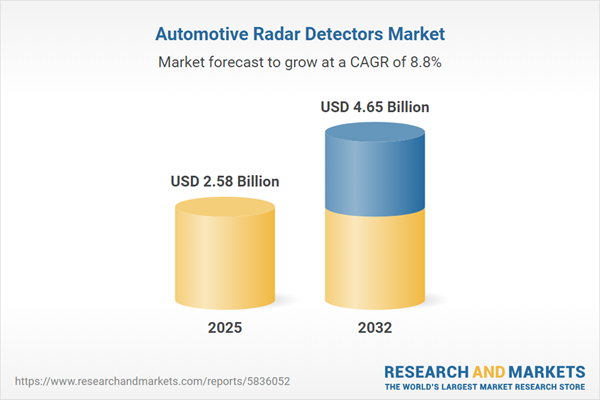Speak directly to the analyst to clarify any post sales queries you may have.
Senior decision-makers face a rapidly transforming automotive radar detectors market as advances in technology and changing global compliance standards reshape industry priorities. A clear understanding of this market’s dynamics enables leaders to align strategy, allocate resources efficiently, and anticipate emerging challenges and opportunities.
Market Snapshot: Automotive Radar Detectors Market Overview
The automotive radar detectors market is projected for robust expansion, rising from USD 2.36 billion in 2024 to USD 2.58 billion in 2025 and reaching USD 4.65 billion by 2032 at a compound annual growth rate (CAGR) of 8.81%. This momentum is fueled by continuous innovation in compact sensor architectures and digital signal processing, enabling their integration into broader ranges of vehicles. Industry collaboration is intensifying, with manufacturers and technology firms working together to pair radar solutions with cameras and lidar, reinforcing the importance of these systems for current and future automotive safety requirements.
Scope & Segmentation of the Automotive Radar Detectors Market
This in-depth research offers critical guidance to senior executives seeking to identify impactful opportunities and make data-driven strategic decisions within the automotive radar detectors market. The segmentation captures all key aspects driving both market adoption and competitive positioning:
- Frequency Bands: Assesses market trends and regulatory implications for both 24 GHz and 76–81 GHz bands, helping shape industry compliance strategies.
- Installation Pathways: Explores the transition between aftermarket radar detector installation and original equipment manufacturer (OEM) adoption, highlighting evolving purchase patterns and supplier relationships.
- Vehicle Types: Examines integration across both passenger vehicles and commercial fleets, considering unique operational demands and diverse regulatory settings.
- Technology Tiers: Reviews roles for long, medium, and short-range radar systems, detailing their use in primary safety warnings and advanced driver assistance systems (ADAS).
- Applications: Covers practical deployments such as adaptive cruise control, collision prevention, blind spot monitoring, lane departure support, parking assistance, and semi-automated driving.
- Regions: Details activities and compliance considerations in the Americas, Europe, Middle East, Africa, and Asia-Pacific, offering insights into adoption patterns and policy implications worldwide.
- Key Companies: Profiles the strategies of major industry players including Continental AG, Robert Bosch GmbH, Denso Corporation, Aptiv PLC, Valeo SA, ZF Friedrichshafen AG, Infineon Technologies AG, NXP Semiconductors N.V., Texas Instruments Incorporated, and Mobileye N.V. in response to sector transformation.
Key Takeaways for Senior Decision-Makers
- Combined deployment of radar, camera, and lidar drives industry innovation and sets evolving benchmarks in automotive safety and regulatory compliance.
- Collaboration between automotive manufacturers and technology providers is shortening the time to market for advanced safety features, enabling sectoral flexibility.
- Effective strategies must respond to region-specific regulations and differing stages of technology adoption, ensuring local alignment and global reach.
- Diversified supply chains and innovative logistics frameworks are proving essential for risk mitigation and continuity in product delivery.
- Investing in advanced chipsets, sophisticated antenna solutions, and artificial intelligence is fundamental to enabling the progression toward increasingly automated vehicle technologies.
Tariff Impact: Navigating Global Value Chains
Shifts in U.S. tariff policies have led automotive radar detector manufacturers to reassess sourcing and assembly strategies, boosting agility by expanding production in Europe and Asia. Approaches such as bonded warehousing and formalized supplier agreements have contributed to greater pricing stability and logistics reliability. Close collaboration with regulatory bodies also supports the efficient movement of components and finished products across borders.
Methodology & Data Sources
This market analysis is grounded in comprehensive technical evaluation, detailed assessment of cross-regional regulatory frameworks, and benchmarking against verified industry metrics. In-depth interviews with subject matter experts ensure accuracy and relevance for executive decision-making.
Why This Report Matters
- Empowers leaders to compare their market positioning and reveal emerging opportunities in the automotive radar detectors sector.
- Supports alignment of strategic objectives and investment decisions with evolving technology trends and compliance demands in different regions.
- Provides actionable frameworks to strengthen supply chain resilience and optimize operational resource allocation amid automotive market complexities.
Conclusion
This report equips executives to refine their objectives, deepen engagement with critical value chain partners, and confidently navigate the ongoing changes in the automotive radar detectors market landscape.
Additional Product Information:
- Purchase of this report includes 1 year online access with quarterly updates.
- This report can be updated on request. Please contact our Customer Experience team using the Ask a Question widget on our website.
Table of Contents
3. Executive Summary
4. Market Overview
7. Cumulative Impact of Artificial Intelligence 2025
Companies Mentioned
The companies profiled in this Automotive Radar Detectors market report include:- Continental AG
- Robert Bosch GmbH
- Denso Corporation
- Aptiv PLC
- Valeo SA
- ZF Friedrichshafen AG
- Infineon Technologies AG
- NXP Semiconductors N.V.
- Texas Instruments Incorporated
- Mobileye N.V.
Table Information
| Report Attribute | Details |
|---|---|
| No. of Pages | 180 |
| Published | November 2025 |
| Forecast Period | 2025 - 2032 |
| Estimated Market Value ( USD | $ 2.58 Billion |
| Forecasted Market Value ( USD | $ 4.65 Billion |
| Compound Annual Growth Rate | 8.8% |
| Regions Covered | Global |
| No. of Companies Mentioned | 11 |









